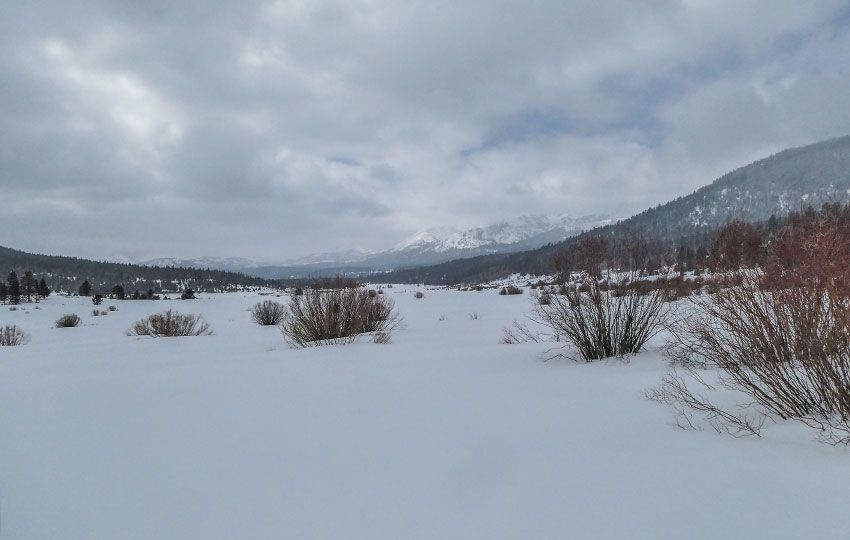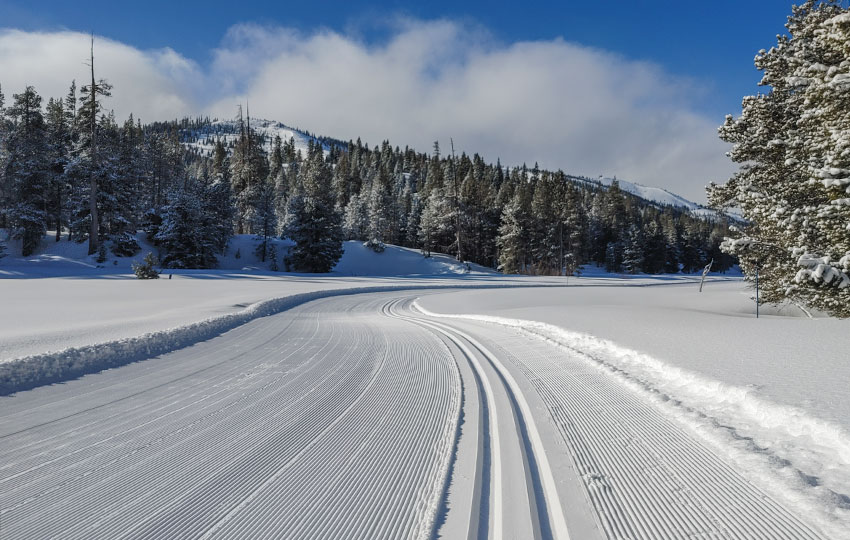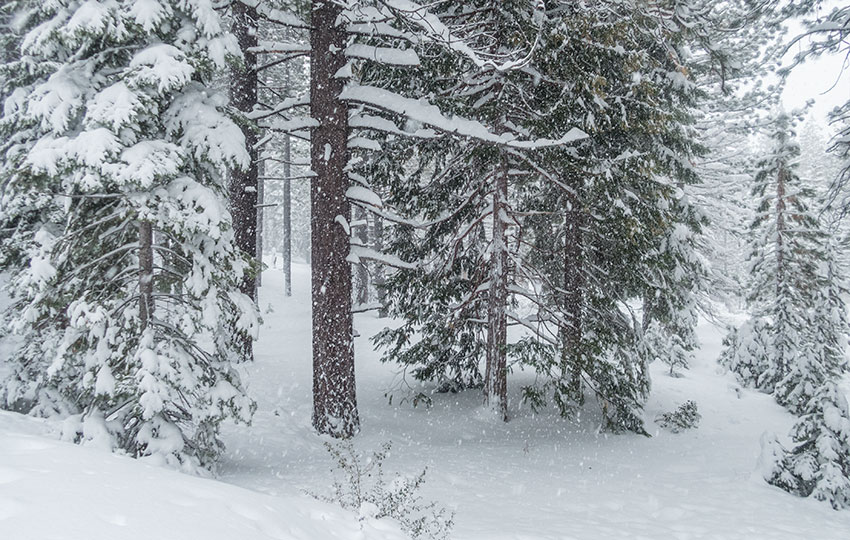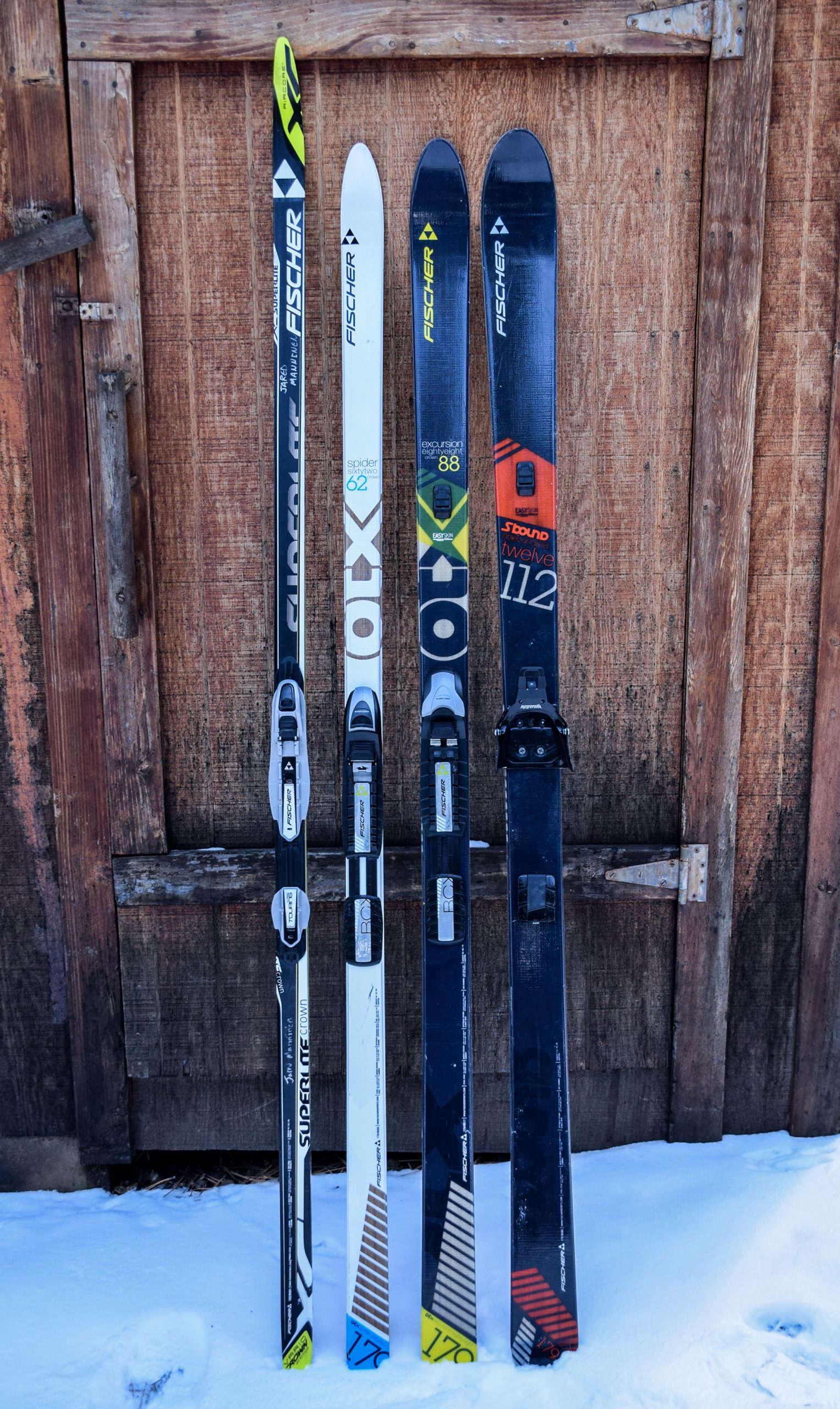
The question of whether or not there exists one set of cross-country skis that’ll allow you to ski in all conditions is on the mind of every person buying their first set of skis. And, for good reason. People want to maximize their fun while spending the least amount of money. They don’t want to have to buy a dozen different sets of skis. And who has the storage space for all of those skis, anyway?
I totally understand this dilemma. And I support universal and utilitarian gear because I’m not a fan, either, of having a bunch of expensive specialized equipment occupying valuable space in my garage.
But here’s the thing. At their essence, cross-country skis are tools for adventure. But, like any tool, they serve a relatively specific purpose. So even though the skills and techniques used are basically the same, skiing at groomed cross-country areas and in the backcountry are two vastly different experiences. As such, both environments benefit from using an appropriate style of ski.
Before getting further into this discussion, though, I will say that … yes, you can technically use one set of xc skis for everything. But, that doesn’t mean you’re going to have fun every time you go out skiing. There’s a good chance that you’re going to become pretty frustrated with that one set of skis when you start pushing them beyond their intended use.
Developing your skills and technique is where you want to put the majority of your effort into your xc ski experience. However, having appropriate gear for the conditions and terrain comes a close second.
Support Tahoe Trail Guide with a financial contribution via PayPal (single contribution) or Patreon (reoccurring contributions). Your support of Tahoe Trail Guide is very much appreciated!

Groomed Versus Backcountry Terrain
Just to keep things simple for this article, I’m talking about groomed and backcountry terrain in their most generic forms.
Groomed terrain is snow that’s been compressed into a flat and uniform surface with parallel grooves (tracks) carved out for classic xc skiing. This could be accomplished by a large and expensive grooming machine that costs over $100/hour to run every night. Or, that terrain could be groomed by an old snowmobile dragging behind it a track pan. The point is that groomed terrain is generally uniform and predictable and features classic tracks.
When I say backcountry (for this article) I’m talking about everything other than purposefully groomed terrain with classic tracks. You could also call this off-track cross-country skiing. Or, you could refer to it as touring. So, I could be talking about anything from a quick jaunt in the forest next to your home or an all-day affair that leads you up (and down!) a 10,000 foot mountain.
The reason for this clarification is that the question of whether or not one set of xc skis will work in groomed and ungroomed terrain is determined specifically by those classic tracks. Most often, people want to know if they can use a wide set of off-track/backcountry cross-country skis in the classic tracks at a groomed resort.
Can I buy a set of wider xc skis that’ll keep me afloat in deep snow, but still use them in the classic tracks at a groomed cross country area?
The answer to that question is … no, not really. Simply put, the classic tracks at a groomed xc ski area are too narrow to accommodate a pair of wide (enough to keep you afloat in deep snow) backcountry cross-country skis. You can still run those wide skis at a groomed xc ski area, but you won’t have access to the benefits of those classic tracks. Instead, you’ll have to ski in the open skate lane next to the tracks. This isn’t the worst thing in the world, but it pretty much negates the reasons for skiing at a groomed xc ski area.
Below I explain in more depth as to why I believe that there’s not a one-size-fits-all cross-country ski that’ll accommodate all environments.

Classic Cross-Country Skis for Use on Groomed Terrain
I realize that most people probably won’t ever race competitively. However, no matter what your intentions are for your cross-country skiing experience you need to understand one thing. Classic cross-country skis, for use on groomed terrain, are designed to be run for long, straight distances at a swift pace.
Those “track” skis are intended to be run in the parallel tracks laid by a grooming machine. These classic tracks are typically laid in straight lines for long distances. Even around corners, the tracks are usually created so that their curve is modest (not severe). This is to discourage the traditionally long and straight classic skis from popping out of those tracks when cornering. And, those tracks are never more than 70mm wide.
Classic tracks are the very reason why many people enjoy skiing at a groomed cross country area. The tracks enable a person to classic ski more efficiently for longer distances at a faster pace.
Whether or not you ski fast is irrelevant, though. The skis are designed to go fast. This is evidenced by their geometry and features. For example, classic track skis are long, straight, and skinny. They have a double camber and a small grip zone. And, they don’t have metal edges.
Long
Track skis are typically 165-205cm long, which enables them to track straighter (more efficient) and offer more glide (faster). But those long skis can be challenging to manage in tight spaces.
Straight
The sidecut (width of tip and tail in relation to the ski’s waist) of track skis is generally no more than a dozen millimeters which enables the ski to track straighter (more efficient). But a straight ski is also harder to turn, particularly on the downhills.
Skinny
Skinnier skis offer less resistance up front (faster) and generally range between 40-58mm wide. This narrow width also prevents the skis from “pinching” in the groomed tracks, particularly around corners. At the same time, finding your balance point on one of those skinny skis can be challenging.
Double (Stiff) Camber
The second camber of a track ski is essentially in the middle of the ski and over the grip zone. The camber’s stiffness prevents the grip zone from dragging over the snow, allowing you to achieve better glide (faster). However, you need to employ good technique in order to compress the ski flat so that you can engage the grip zone in order push off effectively.
Small Grip Zone
A track ski’s grip zone is typically small which, again, allows you to glide better (faster). But this small grip zone does require you to have good technique, otherwise you’ll be constantly slipping.
No Metal Edges
Track skis don’t have metal edges in order to decrease the weight of the ski (less fatigue for the skier) and the amount of friction the ski experiences as it glides (faster). The lack of a metal edge also yields a more forgiving edge to the track ski. In other words, you don’t have to fear cutting into the snow or “catching an edge” nearly as much with track skis. By the same token, it’s more challenging to control your skis on downhill sections of terrain in firm snow conditions without metal edges.

Classic Cross-Country Skis for Off-Track and Backcountry Terrain
Classic cross-country skis designed for use in the backcountry share many of the same features and overall design concepts with their groomer-oriented brethren. However, they’re created to allow you to access more terrain in a safer manner. They’re easier to maneuver around natural obstacles, and in variable terrain and unpredictable snow conditions. They’re also more durable and able to withstand the additional pressure placed upon them due to the more extreme conditions found in the backcountry.
Backcountry cross-country skis are shorter, curvier, and wider than their track ski counterparts. They also feature a softer camber, a more aggressive grip zone, and most have metal edges. All of these variations (in relation to track skis) ultimately provide more control in those variable backcountry scenarios.
Now, I know the thought of having more control is very appealing to beginner cross-country skiers. However, I find that most of those features incorporated into backcountry-oriented xc skis actually make it more difficult to control them in firm snow conditions. And, that’s essentially what you’ll be dealing with at a groomed cross-country ski area. I realize that this sounds counterintuitive. However, continue reading for more explanation.
Short
Manufacturers of backcountry cross-country skis typically make them in 3-5 different lengths. And, those lengths are significantly shorter than what a person would normally run with a track ski. For example, I generally run 179cm backcountry xc skis and 192cm track skis (both lengths are based on the manufacturer’s weight recommendations). The shorter ski allows for better maneuverability (control) in variable terrain. At the same time, it makes it more challenging to keep them tracking straight. And, you’ll achieve less glide compared to running track skis.
Curvy
Although a far cry from a parabolic-shaped alpine ski, backcountry cross-country skis still feature a more prominent sidecut compared to track skis. This more aggressive sidecut makes it slightly easier to turn (control) when skiing downhill. But that curvy sidecut also makes it harder to get the skis to track straight, particularly on firm or icy snow. Many people refer to their skis as being “squirrely” in this situation because the skis will want to travel in every direction other than straight ahead.
Wide
Backcountry cross-country skis come in widths generally ranging from about 60-125mm. This measurement is often the widest part of the ski nearest the tip. As I’ve mentioned (more than once), the tracks at a groomed resort are barely 70mm. So nothing wider than 65mm will really fit in them. But skis narrower than 60mm will just cut into snow that’s deeper than a few inches. At that point, you’re basically wearing long and skinny snowshoes. So, the wider the ski, the deeper the snow it can handle (control). And wider skis are absolutely necessary in snow deeper than even a few inches in many situations.
I also want to be clear that … running wide backcountry xc skis on firm, hard-packed, and icy snow is the worst. I can’t emphasize enough just how bad it sucks to run a fat ski across wind-scoured and crusty snow. Interestingly, many people believe that a wider ski will offer more stability on firm snow (i.e. a groomed surface). Perhaps this is true, up to about 60mm. But for cross-country skis wider than 60mm, I find that this couldn’t be further from the truth.
The bottom line is that it’s difficult to effectively edge a wide cross-country ski on a firm and flat surface. However, this is often the result of the xc ski boots. Most backcountry cross-country ski boots (what you’ll be wearing with wide skis) are still soft compared to alpine or tele boots. The softer boots enable an xc skier to naturally maneuver and perform diagonal striding. But, those softer boots also require the skier to exert more effort (and sometimes weird body angles depending on terrain) to manipulate the skis so that they don’t slide all over the place (squirrely) when negotiating hard-packed snow.
Stiffer boots are not the answer to this problem, however. A set of stiffer boots simply leads you further away from cross-country skiing, and closer to Alpine Touring or Telemark skiing. Not that there’s anything wrong with AT or Tele skiing. They’re just two completely different modes of winter travel compared to cross-country skiing.
Soft Camber
Backcountry xc skis feature a marginally stiff camber to aid in keeping the grip zone from dragging too much when gliding. But they’re way softer than a track ski’s double camber. That said, even though you’ll most likely drag the grip zone a lot more with backcountry skis, that softness enables you to achieve greater grip (control) for pushing off.
Long and Aggressive Grip Zone
Sometimes the grip zone on backcountry cross-country skis makes up half of the base of those skis. This definitely causes more drag to occur when gliding. But it also provides you the most effective way in which to grip the snow (control) in order to push off.
Metal Edges
The metal edges incorporated into the design of backcountry cross-country skis provide more friction. In this case, that’s a good thing because it means more control. The metals edges also increase the ski’s durability. At the same time, it’s a lot easier to catch an edge with metal edges, especially when it comes to firm snow conditions.

Conclusion about Using One Set of XC Skis for Groomed and Backcountry Terrain
There are countless variations of classic cross-country skis beyond traditional track skis and super wide backcountry xc skis. For example, there are also “touring” style xc skis which are often slightly wider than track skis but don’t have metal edges. These types of skis are versatile as you can often use them in the tracks (they’re usually about 60mm wide) and in the meadow by your house. But, again, they’re stuck somewhere in the middle because they’re not long and skinny enough to be efficient in the classic tracks. And, they’re definitely not wide enough to keep you from sinking in deeper snow.
Regardless of style of cross-country ski, the rule of thumb is that if it’s wider than 65mm it’s not going to fit in the classic tracks at a groomed cross-country ski area. And, the whole point of classic skiing at a groomed cross-country area is to be able to use those tracks.
The other side of that equation is that if the ski is less than 70mm wide, it’s not going to be very versatile in a backcountry scenario where there’s more than a few inches of fresh snow. That said, I do use my Fischer Spider 62mm skis often in the backcountry. However, I usually use them in the beginning of the season when there’s very little snow on the ground. Then I use them again in the spring when the snow is consolidated and firm and I don’t have to worry about sinking into soft, fresh snow.
Another rule of thumb that I use is that I run skinnier skis on firm snow and wider skis in deep and soft snow. Skinny skis are easier to edge on firm snow, but they won’t keep you afloat in deep snow. And, wide skis are difficult to edge on firm snow but will keep you afloat in deep snow.
My recommendation is to first purchase classic cross-country skis for the terrain on which you’ll be skiing the most. Then, down the road, invest in another set that will accommodate other environments in which you’ll want to ski. I realize that this will wind up being more expensive, but the benefits far outweigh the few hundred dollars that you’ll spend buying that second pair of xc skis.
So, have a dedicated classic track ski for use at groomed cross-country ski areas. Then, have a wide backcountry-oriented ski (80mm or wider) to use for venturing out into the great unknown. With those two sets of skis, you’ll be able to negotiate most snow conditions throughout any season. And you’ll have a great time doing so!
Cross-Country Downhill #ad maybe slightly dated (published c. 1987), but it provides some wonderful philosophy about cross-country skiing off the beaten path.
There’s also a lot of technical information regarding learning the Telemark turn on lighter cross-country touring gear. Highly recommended for those of you looking to cross-country ski in the backcountry.
Keep in mind, however, that this book is written with a more advanced mountain adventurer in mind. Follow the Amazon link and you should be able to find a used copy.
Cross-Country Skiing Explained Articles and Videos
Please note that I wrote and produced the Cross-Country Skiing Explained series of articles and videos with the beginner and intermediate cross-country skier in mind. This is the demographic for whom I most often serve(d) while working in the outdoor recreation industry at Lake Tahoe. I basically treat these articles and videos as extensions of the conversations that I have (had) with those customers.
That said, expert skiers probably could take away something of value from these resources. Just know that I don’t address race-oriented philosophy, technique, or gear selection.
Considerations for buying cross-country ski gear (new and beginner xc skiers)
- Intention, Types of XC Skis, and Whether to Buy New or Used (Part 1)
- How Much Gear to Acquire, Evaluate Your Commitment, Value of Taking XC Ski Lessons (Part 2)
- Can One Set of Classic Cross-Country Skis Work for Groomed and Off-Track XC Skiing? (Part 3)
- Can I Use One Set of XC Ski Boots for All of My Cross-Country Skiing Needs? (Part 4)
- Overview of Off-Track and Backcountry Cross-Country Ski Gear
- Invest in Technique More than Gear
Classic Cross-Country Ski Components
- Introduction to Classic Cross-Country Skis (Part 1)
- Geometry of Classic Cross-Country Skis (Part 2)
- The Grip Zone of Classic Cross-Country Skis (Part 3)
- Types of Bindings for Classic Cross-Country Skiing (Part 4)
- Ski Boots for Classic Cross-Country Skiing (Part 5)
- Classic Cross-Country Ski Poles (Part 6)
- FAQs about Classic Cross-Country Skiing
Waxing Your “Waxless” Cross-Country Skis (for beginner and intermediate xc skiers)
- Introduction to Waxing Your Waxless XC Skis
- Step-by-Step Waxing Tutorial
- FAQs About Waxing Your Waxless XC Skis
Cross-Country Skiing Techniques, Demonstrations, and Related Concepts
- Outdoor VLOG (emphasis on the cross-country skiing experience)
- Cross-Country Skiing in Challenging Conditions
- Considerations for Winter Adventure in Lake Tahoe’s Backcountry
- Using the Side-Step and Herringbone Techniques in the Backcountry
- 10 Tips for Spring Cross-Country Skiing in the Backcountry
- 5 Reasons to Love Spring Cross-Country Skiing
- Considerations for Cross-Country Skiing During the Fall and Early Winter
- Discussing the Goal of Becoming a Better Cross-Country Skier and Embracing Backcountry and Groomed Terrain in Pursuit of that Goal
- The Cross-Country Skiing Experience: Immersing Yourself in Winter